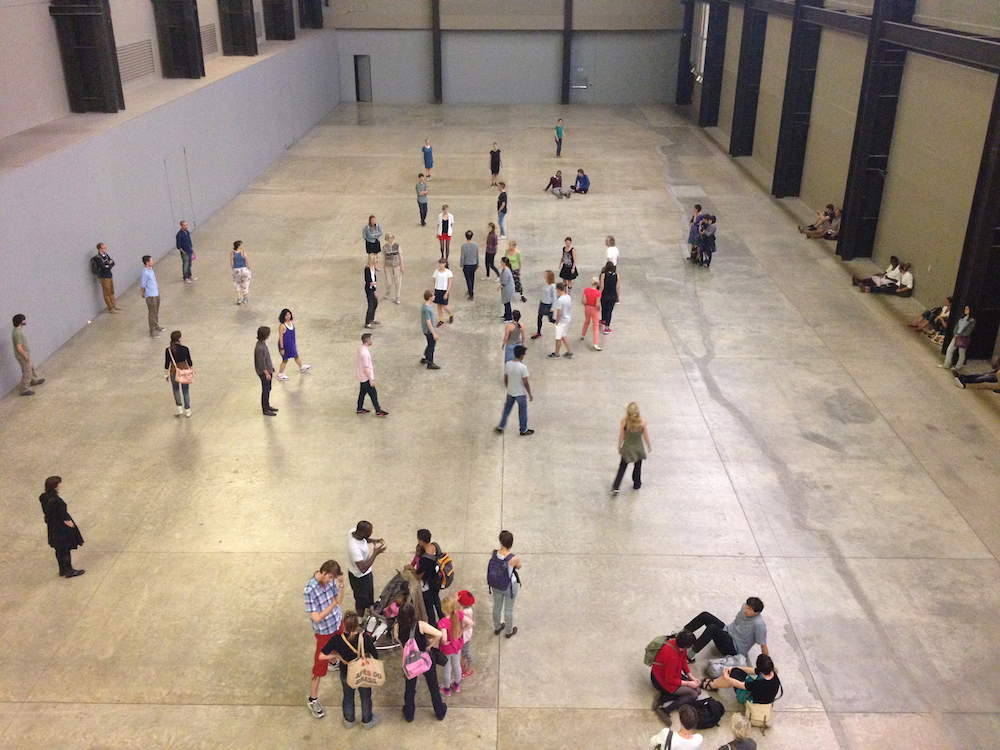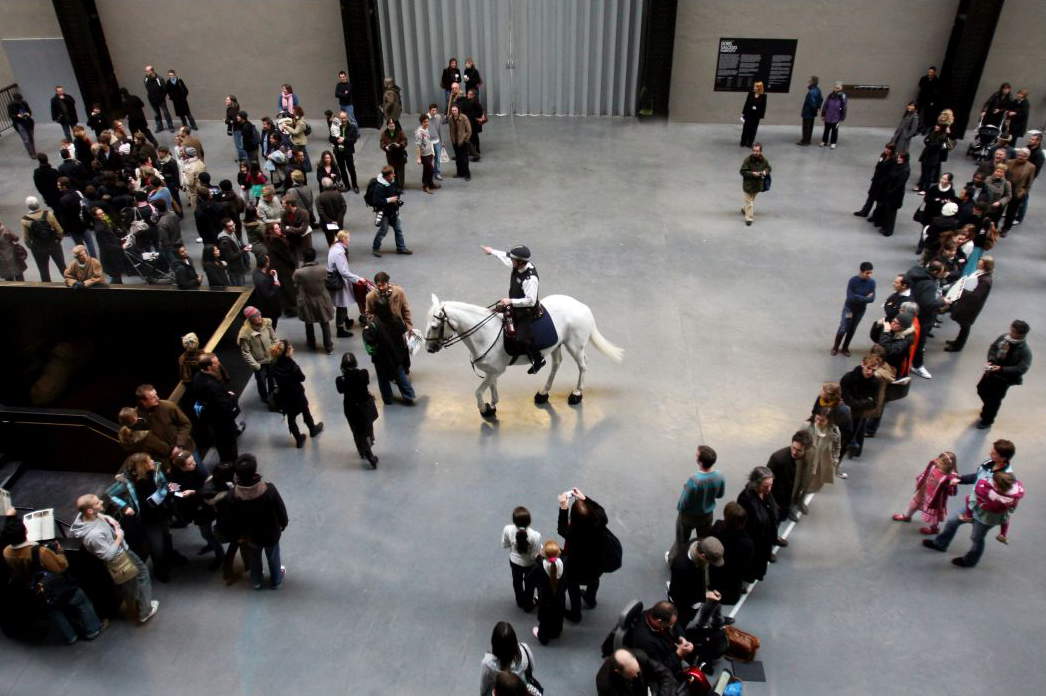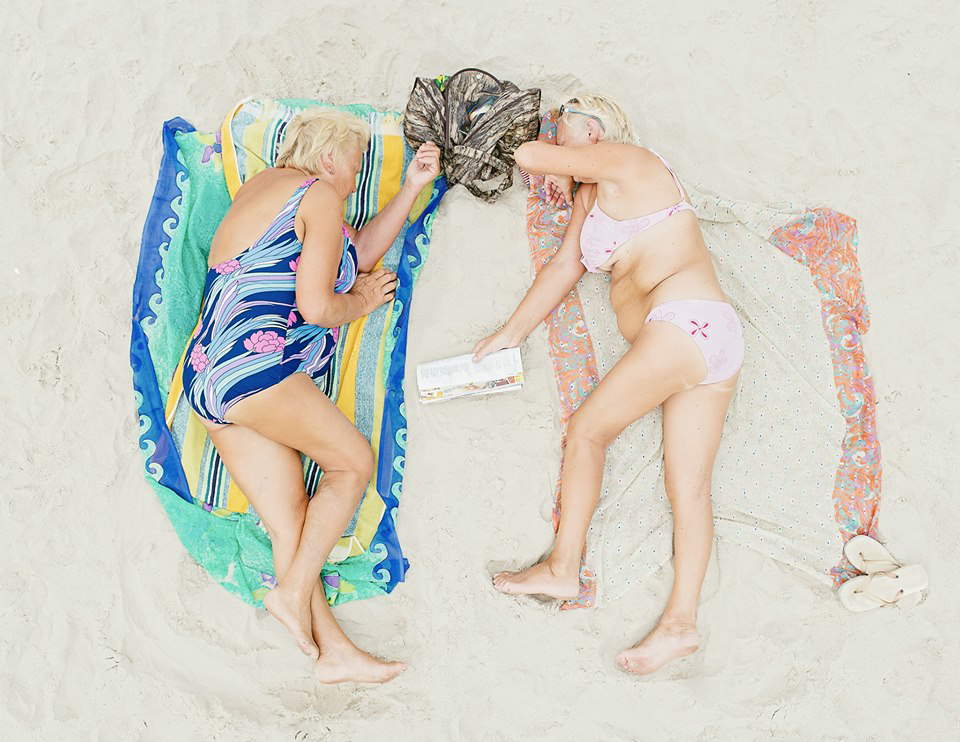It was not difficult to predict that Lithuania’s pavilion would win the almost unanimous appreciation of the public at the Venice Biennale, as well as many insiders, although, perhaps, it was not so obvious to imagine that the performance curated by Lucia Petroiusti and staged by the three artists Rugilė Barzdžiukaitė, Vaiva Grainytė and Lina Lapelytė would be deemed so convincing as to deserve the Golden Lion. So, now it’s easy to imagine that audiences will be queuing up to crowd the warehouse near the Arsenal where the three Lithuanian artists have recreated a mock beach filled with figures sunbathing on their beach towels, reading books and flipping through magazines, making sand castles, walking dogs, and all the while intoning operetta tunes expressing their concerns, from the most mundane (what sunscreen to use, how to avoid being bothered by the neighbor’s little dog) to the most pressing and global, above all climate change, the real protagonist of this sort of living nativity scene in a summer setting (and the comparison, mind you, is not meant to be ironic). Insiders’ comments in the Biennial preview mostly focused on the emotional component of Sun & Sea (Marina) (this is the title of the performance, although both sun and sea are missing in the work): it was not uncommon to come across colleagues who found the spectacle offered by Barzdžiukaitė, Grainytė and Lapelytė exciting, enthralling, ecstatic.
And indeed, theappeal of this seemingly carefree beach, of this colorful holiday setting reproduced by the Lithuanian artists inside a Navy space, of this piece of humanity that symbolizes the end of the world as it is imagined by its authors, according to whom it will be the apathy, resignation, and individualism of human beings that will lead us to a destruction that will not be caused by sudden upheavals, but simply by the constancy of our laziness. It is therefore easy to understand, on the one hand, the reasons for this work’s fascination with the audience, and on the other hand, the motivations that led the international jury (also all-female) to award the Lithuanian pavilion: Sun & Sea (Marina) deals with an extremely topical issue with extreme lightness, addresses the audience with winking ease, uses the language of the musical, and is therefore presented in completely familiar tones that succeed in bringing even the most reluctant portions of the public closer to performance art.
 |
| Lithuania’s pavilion at the 2019 Venice Biennale. Ph. Credit Andrea Avezzù. Courtesy La Biennale di Venezia. |
 |
| The pavilion of Lithuania. Ph. Credit Andrea Avezzù. Courtesy La Biennale di Venezia. |
So if it is clear to understand why the pavilion was awarded, more arduous is to understand what was awarded: evaluating Lithuania’s victory at the fifty-eighth Venice Biennale could be, for example, a good exercise to question the extent of the boundaries of performance art and the elements that separate it from theater. That is, at least, if one is to follow Marina Abramović when she stated in a 2010 Guardian interview that to be a performer one must hate theater, since theater is fiction while performance is the exact opposite: and Lithuania’s pavilion appears to be the domain of fiction; it is a large tableau vivant that the audience observes from above without any active involvement, in ways that are not so far removed from those of certain forms of entertainment in Victorian England (and which, moreover, did not even have great artistic pretensions).
One then has to wonder how much is new, original, experimental in Sun & Sea, which seems like a sugary, sweetened, child-friendly, mellifluous and polite version of performances by Tino Sehgal or Tania Bruguera. Works that, in addition to being endowed with far greater depth (the Lithuanian pavilion inexorably dematerializes when compared with Tino Sehgal’s works such as This is so contemporary, moreover presented at another edition of the Biennale, or These Associations, or with a performance such as Tatlin ’s Whisper by Tania Bruguera, which at first glance would seem to constitute the most immediate precedents of Barzd&zcaron’s work;iukaitė, Grainytė and Lapelytė), and to have certainly proved stronger and more incisive than the little theater set up in the space near the Arsenal, were more closely related to that element of presence that many critics have identified as the foundation of performance art. Golden Lion, then, to an experience that, to be generous, could be described as a mannered, sluggish, and colorful reprise of the constructed situations and de conducta art of the aforementioned artists. Not only that, there are those in Lithuania, on social media, who pointed out the extreme similarity between the work of the three women artists awarded at the Biennial and a 2013 work by a photographer also from Lithuania, Tadao Cern: Entitled Comfort zone, it was a series of photographs capturing, from above, unsuspecting bathers on the beach, reread as a place where humanity lives in the most total absence of worries (precisely a comfort zone in which no one, once they take off their clothes, cares about the judgment of others or, at least, wears a mask that conceals flaws, vices, imperfections).
 |
| Tino Sehgal, These Associations (2012) |
 |
| Tania Bruguera, Tatlin’s Whisper #5 (2008, pictured is the 2016 Tate Modern performance) |
 |
| Tadao Cern, Comfort Zone (2013) |
Finally, one must ask whether the Golden Lion for Lithuania in this edition of the Venice Biennale could be seen as an attempt to shorten the (undeniable) distance between contemporary art and the general public. An attempt that, in the case, would undoubtedly be clumsy, however irrefutable is the fact that, for a certain idea of art that is particularly widespread today (and according to which art must be customary and, in some ways, reassuring), valid for both ancient and contemporary art, the Lithuanian pavilion represented in this sense the most successful work of the whole Biennale (and, again from this point of view, there does not seem to be much distance between Sun & Sea and, for example, yet another blockbuster exhibition on Frida Kahlo or the Impressionists, or museum visits turned into “beauty walks,” as Gramellini put it). But in this case there is perhaps another aspect to try to reflect on.
In one of his recent essays on the representation of differences in contemporary art (which Italian audiences can easily find in the book Che cos’è dunque l’altro?, published this year), Marc Augé reiterated, among other things, that the main objective of art, rather than subverting, is to show, and that in order to succeed in seeing and showing “one needs to find perspectives, to experiment and shift the allowed limits, to lower observation into time and space,” adding that, for example, in the field of film, the most interesting productions are those that abolish the boundaries between fiction and documentary. In the case of Sun & Sea, the problem is not so much that the work resembles pure (and unimpressive) abstraction rather than context, nor is it the failure to experiment with new ways of providing the public with a representation of reality (there is nothing wrong with a work that is unoriginal, nor is it to be expected that the Biennale will reward originality at all costs): the problem, if anything, is that this work would seem to be chasing after the languages of other forms of creative expression, rather than combining them to produce a high and consistent result (as Laure Prouvost at the French Pavilion did so brilliantly, just to advance an example that remains within the confines of this year’s Biennale), and it is idle to recall that, in art as in any other field (starting with politics), chasing and imitation can do nothing in the face of the original.
Warning: the translation into English of the original Italian article was created using automatic tools. We undertake to review all articles, but we do not guarantee the total absence of inaccuracies in the translation due to the program. You can find the original by clicking on the ITA button. If you find any mistake,please contact us.